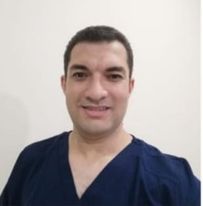Scientific Program
Keynote Session:
Oral Session 1:
- Allergies | Facial Surgery | Head Region | Throat | Ear | Pediatric Conditions
Title: Adenoid Cystic Carcinoma: A blessing in disguise
Biography:
Abstract:
Adenoid cystic carcinoma has been reported in the literature to occur between 1-4.5% among the head and neck neoplasms and up to 50% in minor salivary glands as compared to the major salivary glands. The neoplasms occuring in the minor salivary glands have poor prognosis as compared to those occuring in the major salivary glands.
Apparently when the diagnostic introspection occurs in differentiating the adenoid cystic carcinoma from other commonly ocuring tumors in the minor and major salivary glands such as pleomorphic adenoma, canalicular adenoma, muco- epidermoid carcinoma, adeno carcinoma, necrotizing sialometaplasia etc, the immuno histochemistry helps as a main tool in diagnosing the adenoid cystic carcinoma to that of other entities including its sub-types, when the histopathological diagnosis is in contemplation, particularly when the perineural spread /invasion cannot be appreciated with regards to minor salivary glands in certain instances.
This presentation emphasises the correlation of histopathology findings with that of immuno histo chemitry for confirmatory diagnosis, particularly due to its rarity of occurence in sub-sites of head and neck such as oral cavity, soft palate, hard palate, posterior pharyngeal wall, maxillary sinus and paranasal sinus region etc. A congregation of 11 cases is presented here with in this regard.
Title: Post auricular soft tissue versus autologous cortical bone graft in mastoid cavity obliteration: A comparative study
Biography:
M. B. B. Ch, Mansoura University 2008, Master degree in Otorhinolaryngology, Tanta University 2014, MD in Otorhinolaryngology, Mansoura University 2021.
Abstract:
Objectives: compare the results of partial mastoid cavity obliteration with post auricular soft tissue flap versus autologous cortical bone graft after canal wall down mastoidectomy as regard the healing process, control of infection and creation of dry mastoid cavity.
Methods: Sixty cholesteatoma patients had done canal wall down mastoidectomy then divided into two groups, Group (A) (30 patients) in whom partial mastoid cavity was obliterated with post auricular soft tissue flap using Palva flap (anteriorly based muscloperiosteal flap) followed by meatoplasty. Group (B) (30 patients) in whom partial mastoid cavity was obliterated with autologous cortical bone pate followed by meatoplasty.
Results: healing process was assessed by Merchant grading system showing no patients with persistent discharge and no residual or recurrent cholesteatoma in group (A) with 6.7% in group (B) with constant discharge and recurrent/residual cholesteatoma. Patient satisfaction was assessed using Glasgow benefit inventory survey that showed 90% in group (A) and 83.3% in group (B) had good patient satisfaction.
Conclusion: There was no statistical significant difference between mastoid cavity obliteration using Palva flap and by autologous bone pate/chips as regard healing period, otorrhea, postoperative complications, residual/recurrent cholesteatoma and patient satisfaction 12 months after surgery.
Title: THYROGLOSSAL DUCT CYST
Biography:
Dr. Leonardo Colorado Aguirre is a Postgraduate doctor of the Otorhinolaryngology Service of the General Hospital of the North of Guayaquil Los Ceibos (IESS) – Teodoro Maldonado carbo Speciality Hospital (IESS) – Francisco Icaza Bustamante Pediatric Hospital (MSP), Guayaquil. The area of knowledge includes care in the Emergency area, Inter consultations, Hospitalization and Surgery of the Otorhinolaryngology Service.
Abstract:
Introduction
The most frequent congenital cervical anomalies can form anywhere along the thyroid's migration path from the base of the tongue to the bottom of the neck. They often present as midline neck cysts closely associated with the hyoid bone. It is observed in 70% of all cervical masses in children, 7% of the adult population. There is an equal prevalence between men and women which is closely associated with the hyoid bone. Carcinoma on a CT scan is very rare (less than 1%). They are more common in women. Papillary Carcinoma (90%), Squamous Cell Carcinoma (5%). It usually presents in the third or fourth decade of life. They are Asymptomatic. They can occur at any age as Cyst, abscess, fistula, or tumor anywhere along the path of the thyroid gland. The mass will rise with tongue protrusion or during swallowing (reliable clinical sign for diagnosis).
Treatment
Require surgical removal to prevent recurrent infections due to small risk of malignancy. Simple excision is associated with high recurrence rates (45-55%). SISTRUNK OPERATION is a standard surgical treatment.
Diagnosis: Histopathology
Cystic structures lined by respiratory epithelium, squamous epithelium, or a combination of both. Due to a high frequency of infection, inflammatory infiltrates (granulation tissue or giant cells) may occur. In about 70% of cases, microscopic foci of ectopic thyroid gland tissue can be found, usually within the cyst wall.
Postoperative care and Rehabilitation
Pain relievers or antibiotics may be prescribed after the operation depending on the size of the thyroglossal duct cyst, there may be a surgical drain in place, which would be removed a few days after surgery. Avoid lifting heavy objects for 2 to 6 weeks. Patients can usually return to work or school 1 week after surgery.




